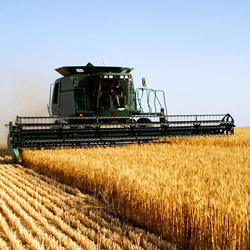| |
Working safely through another harvest season | |
| |
|
|
| |
 Courtesy of Canadian Agricultural Safety Association Courtesy of Canadian Agricultural Safety Association
At harvest, everyone wants to help. Hauling grain, fixing breakdowns, combining, driving to town for parts and supplies and fixing meals to eat in the field are all important tasks during harvest. Harvest is a time where we spend a lot of time apart from our families but all work towards the same goal — a successful and bountiful harvest. However, a successful harvest also means having a safe harvest.
A major component of having a safe harvest is making sure that everyone that helps is trained, competent, and performing tasks according to their skill level. (And don’t forget age-appropriate.)
It’s relatively easy to make sure young people aren’t in over their heads. Understanding that children aren’t miniature adults is the first step. A child might be tall enough, strong enough and smart enough to operate a piece of equipment, but are they emotionally mature? It’s hard to sometimes be neutral when assessing the skill level and emotional maturity of our own children, so that’s why tools like the Ag Youth Work Guidelines (formerly North American Guidelines for Children’s Agricultural Tasks) are so handy. These guidelines help parents and kids determine skill levels and tasks safe to do. Visit cultivatesafety.org for more information.
As difficult as it is to curb the enthusiasm of children who want to help with harvest, it is much harder to curb eager helpers who fall into the “senior” category. However, it’s just as necessary. The most up-to-date Canadian Agricultural Injury Reporting (CAIR) data of agriculture-related deaths shows that older adults (60+ years) consistently have higher fatality rates than children and adults.
The good news is these deaths are preventable.
For instance, senior farmers may sometimes use older tractors and worn-out equipment that are more prone to malfunctioning. Older tractors often have no seatbelts or rollover protective structures (ROPS), so rollovers are frequently fatal. Maintaining tractors and machinery properly and retrofitting seatbelts and ROPS on older tractors would help reduce the incidence of injuries.
If an older farmer must work alone, make sure he lets you know his whereabouts and his schedule, and then takes a cell phone or other two-way communications device that includes a geographic positioning system (GPS).
As we age, we need more light to see clearly. Try to ensure that senior farmers are using their skills before dusk outside rather than in a dimly lit shed. Or increase lighting levels in barns and other buildings to accommodate their vision needs.
There’s more. How’s his hearing? Senior farmers who have difficulty hearing words or sounds may not be able to detect warning signals, such as the sounding of an automobile horn or the approach of a fast-moving animal. Agree to use hand signals that everyone can understand.
Senior farmers have much to contribute. They have the wisdom and experience that many younger workers lack. And, with your help, they can use that enhanced judgment and skill to compensate for the decreases in reaction time and muscle strength that are inevitable, and stay healthy and safe.
From all of us at CASA have a safe and successful harvest! |
|
| |
|
|
| |
For more information about the content of this document, contact Kenda Lubeck.
This information published to the web on October 16, 2018.
Last Reviewed/Revised on October 19, 2018.
|
|